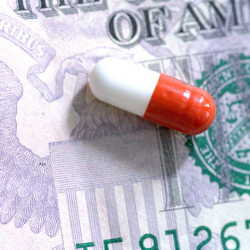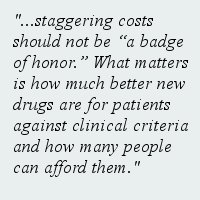Pharmaceutical R&D’s Costly Myths
PLoS Guest Bloggers Donald Light and Rebecca Warburton discuss myths surrounding the costs of developing new drugs.
A recent article in Forbes published in February sets a new record for the “staggering cost” of developing new drugs. The article estimates that R&D costs average between $4-11 billion per new drug, 3-5 times more than the highest estimates made by industry-supported economists at the Tufts University Center for the Study of Drug Development. These record estimates set the stage for more government subsidies and protections (ultimately paid for by taxpayers) than Big Pharma could have ever hoped for.
The article in Forbes references a paper that we published last year in, BioSocieties, which shows the costs of R&D for pharmaceutical companies are substantially lower than $4-11 billion per new drug. We would like to straighten out a few errors in the estimates that the pharmaceutical media, lobbyists, and executives use to justify high prices and costs to all households who pay for them through taxes or employer contributions.
Firstly, the estimates in Forbes accept company R&D figures uncritically and ignore evidence that what companies count as “R&D” may be broader than the costs of bench, lab, and trial research that make up R&D. Drug companies work hard to hide their real costs from any outside scrutiny. And they never link their alleged costs to how quickly they earn them back at high prices.
Secondly, the estimates in Forbes divide total reported costs by the number of “new drugs.” Given the small number used in the Forbes estimates, for example only 5 in 14 years for AstraZeneca, “new drugs” must mean NMEs or new active ingredients. The big companies turn out many more newly patented variations on existing drugs that involve less risk, time and cost. In other words, the Forbes estimates divide total R&D for research on all products by the handful of NMEs. However, the me-too variations are the main products of R&D, and they account for about 60 percent of the United States’ drug budget.
Third, there is no credible evidence that the failure rate has increased, aside from industry claims. The failure rate used by Forbes is twice the rate used by leading economists for the industry .
Fourth, no one knows the real cost of basic research, the “R” in R&D. It can take from 3 months to 30 years to discover a new active ingredient that works. Much of that cost is borne by others, such as the NIH, other national research programs, venture capitalists funding bio-tech and foundations.
Finally, half of the industry’s average cost of R&D is not real R&D costs at all, but an estimate of profits foregone – a highly inflated estimate of what companies would have made had they put their money in an index fund and not developed new drugs in the first place! Given the staggering cost estimates in Forbes, you might think that drug companies should do just that and become investment banks.
Our own estimate of pharmaceutical R&D is often misquoted as an average of $43 million per new drug, which commentators reject as being absurd. However, we make clear this estimate for the year 2000 does not include the cost of discovery (because it varies greatly and no one has accurate figures), nor the “cost of capital” (for reasons explained in our article which can be read here). Our estimate is the net cost to major companies after taxpayers cover about 50% of their R&D expenses. We use the median cost because the average cost gets inflated by a few costly R&D projects.
In sum, we estimate that the median, net, corporate cost to develop a new drug, based on the confidential cost data that companies reported to their policy research center at Tufts University, is $56 million in 2011, plus the unknown company costs of discovery and the artificial estimate of profits foregone, if you think it should be added. We also show that R&D costs for in-house new active ingredients are much higher, and costs for me-too variations are much lower than this single figure.
Our estimate is almost double the only solid corporate report of R&D costs, which can be found in audited tax returns from the late 1990s. Here companies reported average costs for clinical trials per drug of only $22.4 million. Not $224 million but $22.4 million.
What do we get for all that money?
Forbes is right that staggering costs should not be “a badge of honor.” What matters is how much better new drugs are for patients against clinical criteria and how many people can afford them. Sadly, 85-90 percent of all newly approved products of pharmaceutical R&D are judged by independent review groups to be little better than existing ones. These are the drugs that brilliant marketing turns into huge sales that make up 60 percent of the United States’ drug costs.
But drug companies know what they are doing. Between 1995 and 2010 (the era of the so-called “innovation crisis”), they reported spending $34.3 billion more in R&D and generating $200.4 billion more revenues – not a bad return. Pharmaceutical companies average several times more profit than the Fortune 500. By contrast, if the Forbes figures and business arguments are correct, then nearly all of the global pharmaceutical companies listed in their article would have gone bankrupt between 1997 and 2011.
 Donald Light is a professor of comparative health care policy at the University of Medicine and Dentistry of New Jersey and a founding fellow of the Center for Bioethics at the University of Pennsylvania, where he worries about issues of access, affordability, including vaccines and drugs. For the past three years, he has been the Lokey Visiting Professor at Stanford University. He also runs www.pharmamyths.net
Donald Light is a professor of comparative health care policy at the University of Medicine and Dentistry of New Jersey and a founding fellow of the Center for Bioethics at the University of Pennsylvania, where he worries about issues of access, affordability, including vaccines and drugs. For the past three years, he has been the Lokey Visiting Professor at Stanford University. He also runs www.pharmamyths.net
 Rebecca Warburton is a professor of health economics in the School of Public Administration at the University of Victoria in Canada, where she does economic evaluations of health care services and technology assessment as well as studies of R&D costs for pharmaceutical research.
Rebecca Warburton is a professor of health economics in the School of Public Administration at the University of Victoria in Canada, where she does economic evaluations of health care services and technology assessment as well as studies of R&D costs for pharmaceutical research.



Sure enough, the numbers Herper used are phony. I searched through the FDA drug releases for the last 13 years on AstraZeneca and Glaxo (the top two companies on his list), and got about 15 and 40 releases respectively. Herper quotes 5 and 10.
This blog-post has been discussed by Mark Hoofnagle in his excellent post on Denialism Blog:
Accountability in Science Journalism: two recent examples of failures in the NYT and Forbes
http://scienceblogs.com/denialism/2012/03/accountability_in_science_jour.php